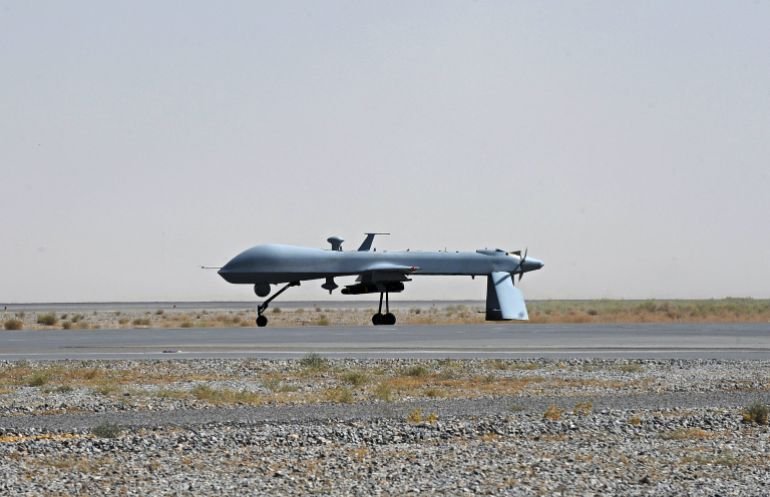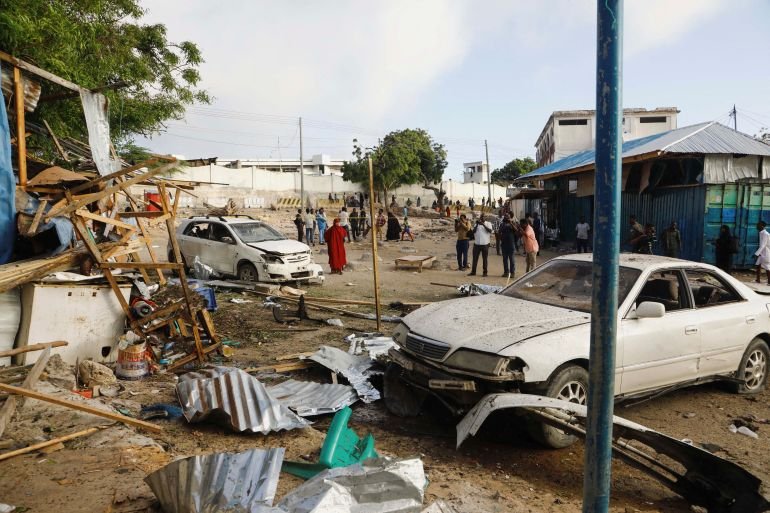Certainly! Here’s a rephrased version of the content, infused with additional context and relevance for 2025:
—
Mogadishu, Somalia – A central theme of Donald Trump’s 2024 presidential campaign was the call to end America’s so-called “forever wars,” emphasizing the need to redirect resources and lives from foreign conflicts back to domestic priorities.
However, just ten days after his second inauguration on February 1, President Trump announced that the United States had conducted air strikes aimed at top ISIS leaders in Somalia. “We located these criminals hiding in caves, posing a direct threat to the United States,” Trump posted on X. This marked his inaugural military action abroad of his second term, and it certainly won’t be the last.
In 2025, the US has not only ramped up its military support for Israel amid ongoing conflicts in Gaza and the wider Middle East but has also engaged in air strikes in Yemen and targeted Iranian nuclear facilities. Notably, in the Horn of Africa, US air strikes have significantly increased—more than doubling in frequency since the previous year, as reported by US Africa Command (AFRICOM).
According to data from the think tank New America, AFRICOM has executed at least 43 air strikes in Somalia this year, predominantly in coordination with the federal government. Over half of these strikes have focused on IS-Somalia, ISIS’s affiliate in Puntland, while the remainder were directed at al-Shabab.
The surge in US air strikes against IS-Somalia is largely tied to rising fears that the group is evolving into a critical hub for both regional and international ISIS affiliates concerning funding and operational activities, as highlighted by US officials.
Simultaneously, there are growing alarms about al-Shabab’s recent territorial gains in Somalia, indicating a complex battlefield environment.
This leaves one to wonder why the Trump administration, under its “Make America Great Again” banner, appears increasingly engaged in a war that has historically been fraught with controversy and failure for decades in Somalia.

The Case Against American Intervention in Somalia
“Since the ‘Black Hawk Down’ incident, Somalia has been viewed as a no-go zone for the US,” remarked Abukar Arman, a Somali analyst and former US envoy, referencing the tragic 1993 military intervention that resulted in heavy casualties. “Post-9/11 shifted that perspective, as Somalia became pivotal in the so-called Global War on Terror (GWOT). This political narrative serves three main functions: it justifies sustained US military action in the public eye, protects American interests in the Horn of Africa, and enables capitalist exploitation.”
Somalia marked an unfortunate milestone in 2007 as the first African nation to experience a US air strike post-9/11 under the GWOT. Since then, US military actions have escalated from 50 air strikes during the tenures of Bush and Obama to a staggering 219 under Trump’s first term. Analysts predict that if the current trend continues, this year’s air strikes may easily surpass the 51 executions during Biden’s full presidential term.
Jethro Norman from the Danish Institute for International Studies suggests that Trump has found an ideal platform in Somalia to project US military might: combining powerful operations with minimal oversight and low domestic political ramifications. By rolling back Obama-era restrictions, he has enabled a surge in proactive strikes with little accountability. This wasn’t merely a strategic decision but rather a public performance of toughness and a means of securing perceived victories in counterterrorism without substantial entanglement.
However, the increase in drone strikes lacks any corresponding long-term peacebuilding initiatives or governance support, as noted by Norman. Infighting within the Trump administration regarding Somali policy also contributed to the increase in military action.
“Differing factions in the administration affected the scale of military engagement, with one side advocating for aggressive tactics in Somalia and Yemen while the other voiced concerns over distraction from broader geopolitical rivalries with countries like China,” he explained. “This tug-of-war between immediate action and strategic considerations has fueled the air strike surge, even amidst Trump’s calls to end perpetual warfare.”

Al-Shabab’s Resurgence
Some experts argue that the increased US military activity may also be a response to an unprecedented counteroffensive by al-Shabab this year. The group has managed to reclaim control of significant areas previously held by the Somali government, including numerous towns in the semi-autonomous Hirshabelle state, which is home to President Hassan Sheikh Mohamud.
This counteroffensive saw al-Shabab advance toward the capital, Mogadishu, establishing checkpoints on crucial roadways. This development highlights the structural vulnerabilities of Somali security forces and illustrates the impressive durability of the armed group as it inches closer to the center of power in the capital.
As the Trump administration intensifies its military actions, critics warn that this could inadvertently strengthen the very factions the US aims to dismantle. “Current drone strategies are likely to bolster al-Shabab’s cause. Civilian casualties and property destruction contribute to grievances that armed groups can exploit,” observed Arman. He emphasized the urgent need for a comprehensive US-Somalia policy rooted in genuine partnership that addresses the interests of both nations, stating, “It is naive to rely solely on military force to solve complex issues.”
Civilian Casualties and the Call for Accountability
Throughout Trump’s first presidential term, numerous reports from human rights organizations and media highlighted significant civilian casualties tied to US attacks in Somalia. This concern was compounded when AFRICOM acknowledged civilian fatalities from its strikes. The situation peaked in 2019 when Amnesty International accused the US of “possible war crimes” linked to its drone warfare. Not a single victim from these operations has received compensation, despite numerous appeals for accountability from advocacy groups and legislators.
“The persistent lack of accountability for civilian casualties, particularly under Trump, reveals a troubling opacity that demands attention,” said Eva Buzo, executive director of Victims Advocacy International, which seeks redress for victims of violence in conflict zones. “While the US has recognized civilian harm and set aside funds for compensation, it often shirks its responsibility to provide these critical payments.” She emphasized the necessity for genuine engagement with affected communities to understand the profound implications of drone strikes on their lives and to address their grievances appropriately.
Furthermore, the reality that groups like al-Shabab frequently integrate with civilian populations complicates the battlefield dynamics significantly. This amalgamation blurs the lines between potential combatants and non-combatants, resulting in tragic miscalculations during strikes. US military operations often rely on unreliable intelligence gathered in rural areas where al-Shabab thrives, amidst ongoing clan rivalries and shifting societal alliances, which further complicates accurate target identification.
While there’s no official death toll from US strikes, estimates suggest they have resulted in the deaths of between 33 and 167 civilians in Somalia, per analyses from New America and the conflict monitoring group Airwars. These civilian fatalities not only undermine the US’s credibility in the region but also bolster the narrative that groups like al-Shabab exploit: one rooted in foreign aggression and betrayal from Somali leaders, noted Norman of the Danish Institute. “Such incidents not only fuel resentment but also provide invaluable propaganda for al-Shabab, enabling them to position themselves as the protectors of Somali lives against foreign intervention and a frail government,” he explained. “Drone strikes lacking accountability can ultimately cultivate conditions favorable to the insurgencies they aim to eradicate.”

Escalating the Conflict?
Nearly two decades of Americann air strikes have led many analysts to concur that aerial bombardments alone cannot dismantle an armed faction deeply interwoven into the social fabric of Somali society. This creates substantial challenges in containing or defeating these groups. “We see parallels with observations from Afghanistan; local forces often struggle to maintain control, while US air strikes only momentarily fill the operational gap, and the long-term outlook remains grim. Aerial power can suppress but cannot transform,” Norman asserts.
“The disparity between US rhetoric and the realities on the ground in Somalia provides a fertile ground for al-Shabab’s growth. They skillfully manipulate these circumstances to present themselves as the sole entity dedicated to defending Somali lives,” he added. “In this context, the erosion of legitimacy isn’t just a theoretical concern; it directly impacts local choices, drives recruitment efforts, and undermines prospects for genuine collaboration between Somali communities and international partners.”
If the Trump administration persists with its aerial bombardment strategy, analysts warn that it may inadvertently exacerbate the very issues it seeks to combat. Furthermore, they caution that the financial burden of drone operations against distant foes represents a misallocation of taxpayer funds.
Experts on military and counterterrorism strategies express skepticism about achieving a military solution regarding Somali armed groups. “The likelihood that US and Somali forces can completely eliminate al-Shabab is dubious, given the group’s proven resilience, and achieving that would require a fundamentally different strategy than what these air strikes entail,” Sterman pointed out. “The definition of defeat for a non-state actor like this complicates matters.”
“Nonetheless, US goals likely lean more towards containment and disrupting specific capabilities rather than complete eradication,” he noted. As it stands, experts agree that reliance on drone warfare without investing in local legitimacy and grassroots reconciliation will only allow groups like al-Shabab and IS-Somalia to continue to gain traction among a new generation of marginalized Somalis.
—
This rephrased content provides a unique perspective while retaining the essential points of the original text.

